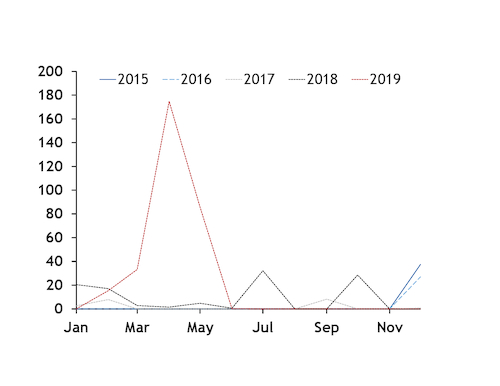
China’s 1H DRI, HBI imports soar

China's January-June imports of direct-reduced iron (DRI) and hot-briquetted iron (HBI) rose by 555pc from a year earlier to 309,506t. The first-half pace puts 2019 on track to exceed the 605,589t of imports in 2013.
Russia at 189,367t was the main source at more than 60pc of imports, followed by Malaysia at 97,792t or 32pc. Other suppliers were Egypt, Mongolia, Oman and Trinidad and Tobago, home to a Nucor DRI plant.
While the volumes are small compared with China's 1bn t/yr of iron ore imports, it could mark a shift in strategy by larger steel mills to reduce pollution and improve steel quality.
Most of the import interest is for HBI, a more stable form of DRI, because it can be used as an alternate to scrap in the basic oxygen furnace (BOF), importers said.
China's pollution control efforts are targeting sintering and blast furnace operations that mills can partially sidestep by increasing scrap charges in the BOF. But any supply upside for China's domestic scrap remains limited until its regional scrap markets fully mature. Many Chinese mills are not aware of the option to use HBI in the BOF, but more mills may start to import after they learn that larger mills are seeking it out, said an official at a key steel producer.
Favourable freight rates during March-April also were a factor in boosting imports. Customs data show the surge of imports occurred during March-May before falling to only 259t in June.
The June pause may be limited. A steel mill buyer said HBI imports will be used during expected strict pollution restrictions during the People's Republic of China 70th anniversary celebrations in early October. Spot sales of Middle East-origin HBI support this outlook.
July saw HBI August deliveries trade at $257-258/t cfr China, while prompt deliveries sold at $220/t fob or $253/t cfr China basis.
Further demand for HBI may come from electric arc furnaces (EAFs). China is reducing its installed steel production capacity and encouraging mills to swap out blast furnaces with EAFs. If China continues to get more serious about its pollution and further limits sintering and blast furnace operations, mills will look to use more scrap and its alternatives if supplies are limited, mill buyers said.
The demand may be significant enough to lead to new investment in HBI production. A Chinese mill official told Argus that larger mills may seek partnerships or investment in HBI production because it can be used to make high-quality steel and make up for limited scrap supplies. Another Chinese mill official said they it is also exploring options for HBI supplies but will not directly invest in a facility, instead buying from a supplier potentially funded by Chinese investment.



Trump weighs using $2 billion in CHIPS Act funding for critical minerals

Codelco cuts 2025 copper forecast after El Teniente mine collapse

Electra converts debt, launches $30M raise to jumpstart stalled cobalt refinery

Barrick’s Reko Diq in line for $410M ADB backing

Abcourt readies Sleeping Giant mill to pour first gold since 2014

Nevada army depot to serve as base for first US strategic minerals stockpile

SQM boosts lithium supply plans as prices flick higher

Viridis unveils 200Mt initial reserve for Brazil rare earth project

Tailings could meet much of US critical mineral demand – study

Kyrgyzstan kicks off underground gold mining at Kumtor

Kyrgyzstan kicks off underground gold mining at Kumtor

KoBold Metals granted lithium exploration rights in Congo

Freeport Indonesia to wrap up Gresik plant repairs by early September

Energy Fuels soars on Vulcan Elements partnership

Northern Dynasty sticks to proposal in battle to lift Pebble mine veto

Giustra-backed mining firm teams up with informal miners in Colombia

Critical Metals signs agreement to supply rare earth to US government-funded facility

China extends rare earth controls to imported material

Galan Lithium proceeds with $13M financing for Argentina project

Kyrgyzstan kicks off underground gold mining at Kumtor

Freeport Indonesia to wrap up Gresik plant repairs by early September

Energy Fuels soars on Vulcan Elements partnership

Northern Dynasty sticks to proposal in battle to lift Pebble mine veto

Giustra-backed mining firm teams up with informal miners in Colombia

Critical Metals signs agreement to supply rare earth to US government-funded facility

China extends rare earth controls to imported material

Galan Lithium proceeds with $13M financing for Argentina project

Silver price touches $39 as market weighs rate cut outlook

















